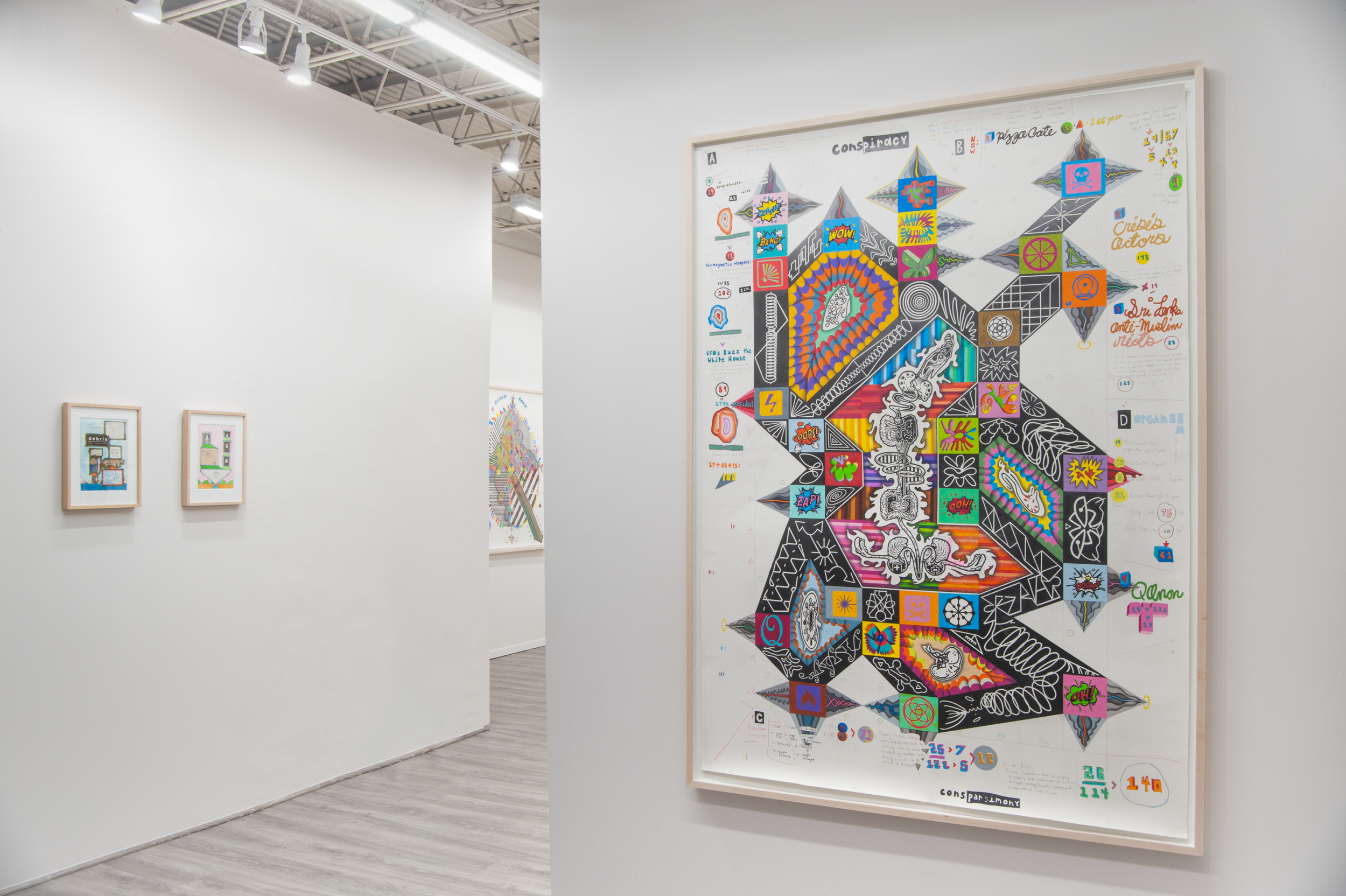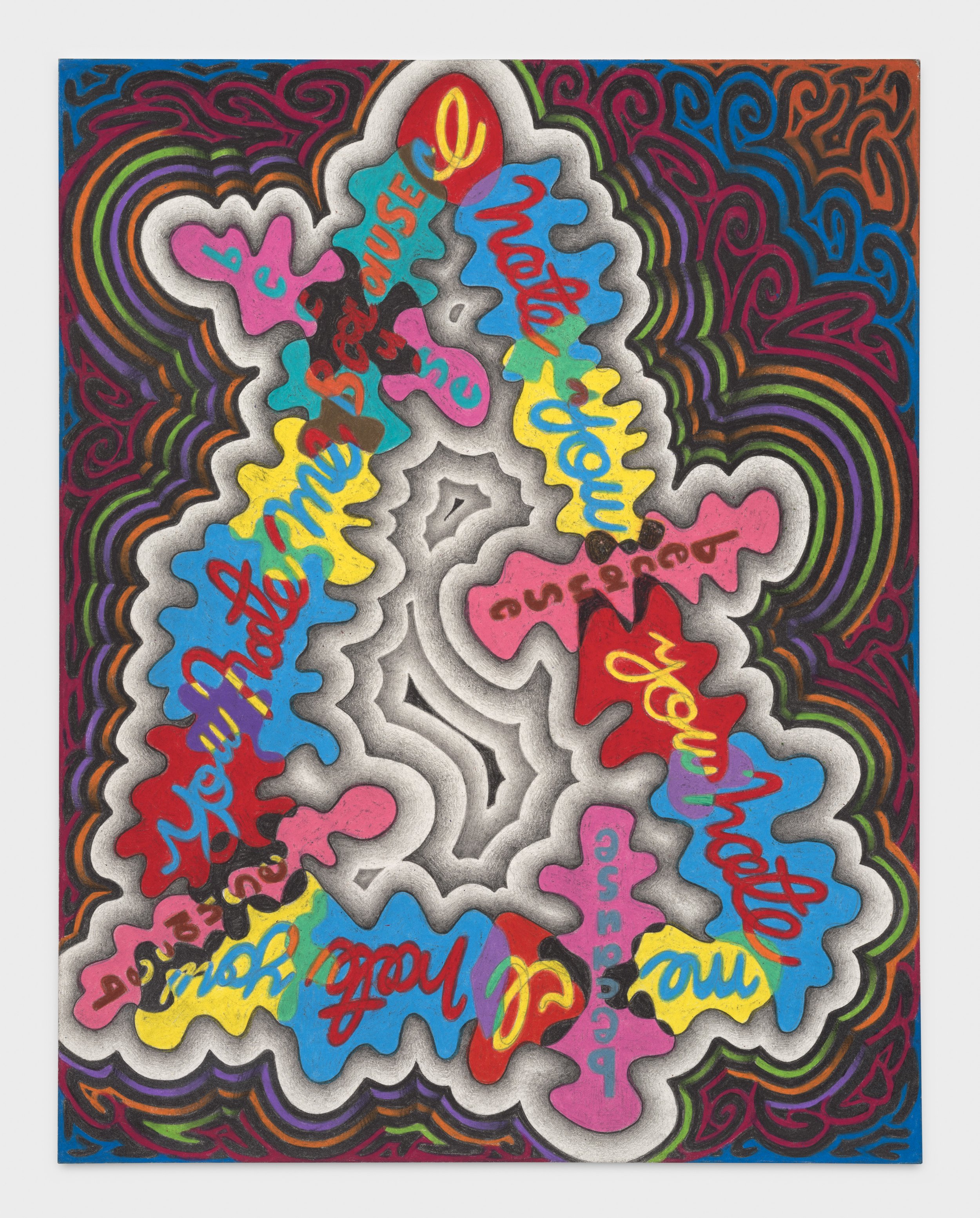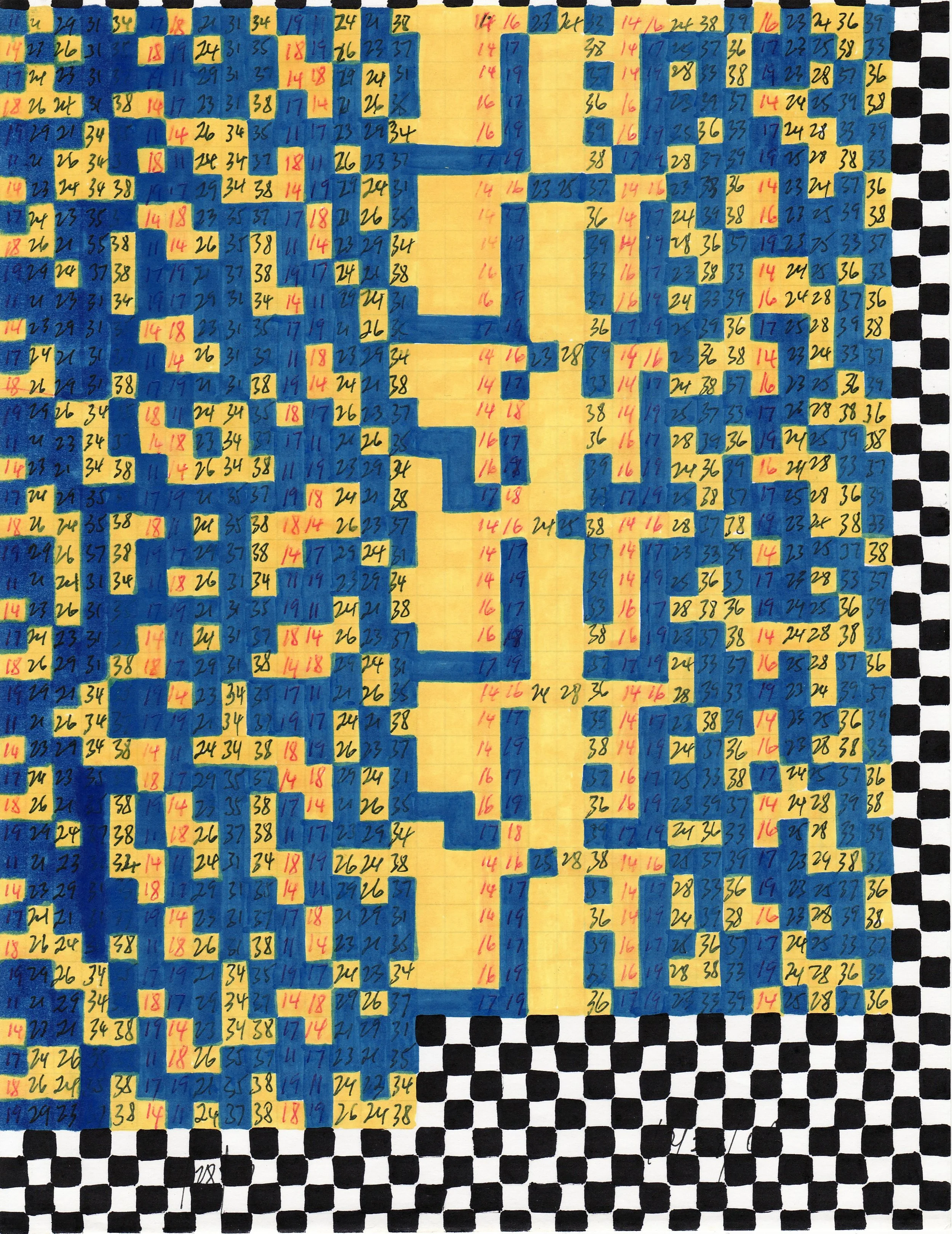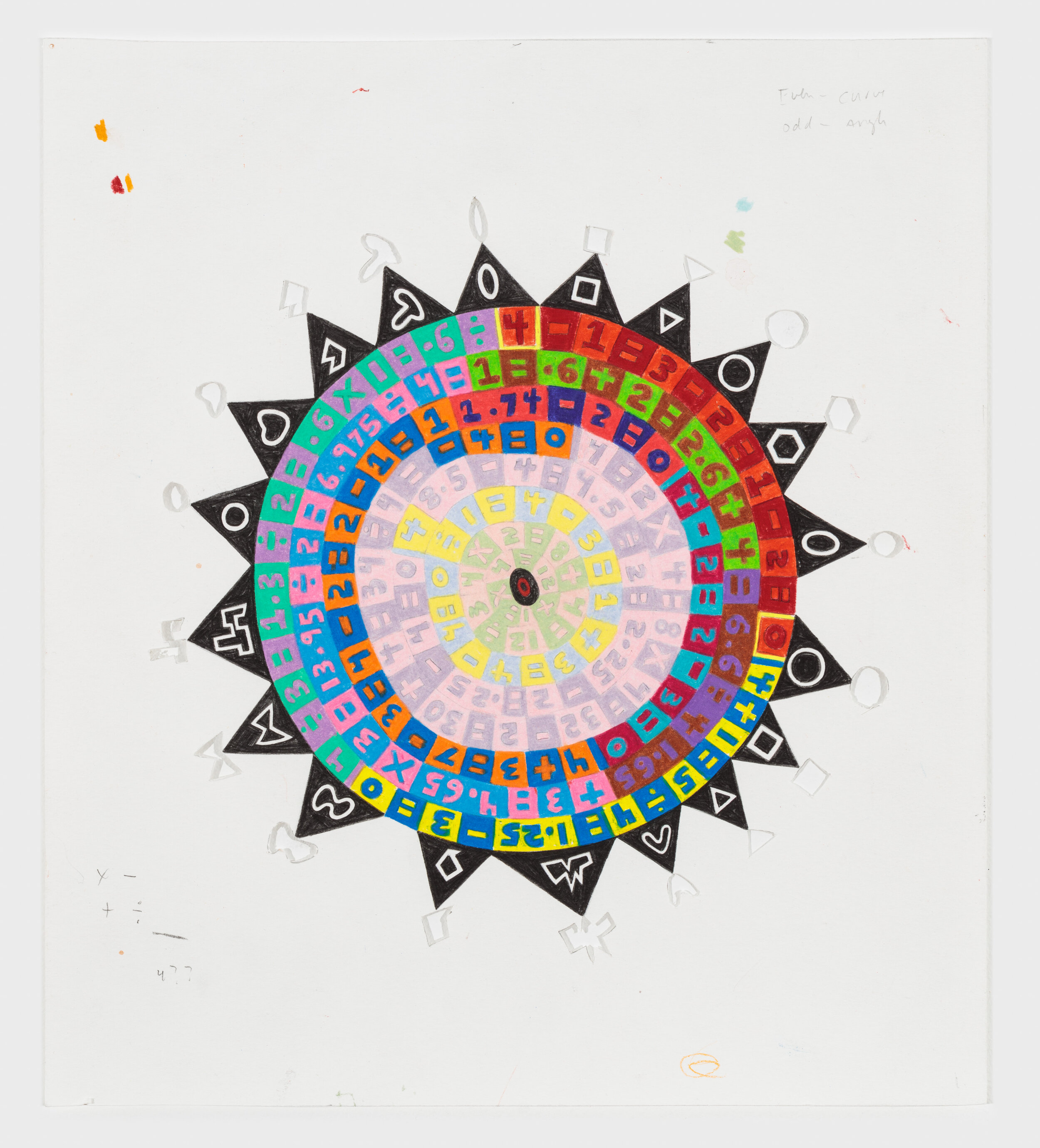
Small Works
Eternal Love Triangle
12 x 9 inches, colored pencil and graphite on paper
1964 to 2030
14 x 9 inches, colored pencil and graphite on paper
This piece is inspired by predictions made in 1981 by 31 graduate students at the University of Houston who were studying future trends. Their research aimed to explore the societal impacts of achieving immortality through medical advancements. For this work, I focused on one specific prediction about personality traits. I merged the written language of this prediction with a pattern system of my own invention, correlating the visual structure with the linguistic framework. The work contains a numerical coding system, mirrored at the start and end. I'm interested in patterns of language that embody humanity's desire to foresee the future -- how does the feeling of the future manifest in words on a page?
One Seventeenth
15.5 x 11 inches, colored pencil and graphite on paper
One work from collaboration with the author Rick Moody
Verso:
ZERO 2 zero
12.5 x 11 inches, colored pencil and graphite on cut paper
In this drawing, I wanted to explore the idea of entropy through basic mathematical procedures. Starting with zero, I randomly applied a mathematical function to each subsequent number, between 0 and 10. I continued this, starting at the center, until the process reached zero again, and then I started a new set. Each phase is colored differently and the shapes cut out at the edges represent a physical void.
Tim (x) Jim
18 x 13 inches, colored pencil and graphite on paper
The snowballing escalation of violence shifts in a comically absurd way, from an innocuous gesture (a look) to an extreme act. Each character’s actions and reactions loop backwards in a way that alters the original gesture again and again.
Cleverbot 1
38½ x 28 inches, colored pencil and graphite on paper
In this piece, I transcribed a series of conversations I had with Cleverbot (an artificial intelligence bot). Unlike other chatterbots, Cleverbot's responses are not programmed. Rather, it "learns" from human input over time – a collective human intelligence through language. When I began my initial conversation with Cleverbot, I spoke to it casually, and stopped abruptly when it threatened me physically – “I’ll punch you in the throat”. After this initial conversation, I began each subsequent one by repeating Cleverbot’s own phrases back to it. I stopped each conversation when the bot said something that seemed either uncanny, or very unhuman.
Night Drawings
Ongoing series of works, each 13 x 19 inches, digital print and colored pencil
I’ve been making these works since 2017. At night, when I go to bed, I place a scrap of paper on my chest and rest a pencil or pen on it. As I fall asleep, the pen makes a line, marking the transition from consciousness into sleep. In the morning, I scan the paper, invert it, and make a print. I then note any dreams I had that night directly on the paper.
Six
25 x 20 inches, colored pencil and graphite on paper
Thought on this work and its relationship to the Butterfly Drawings: I often make number pieces when I'm stuck. I guess I just like the simplicity of mathematical procedures and the patterns that result. In this one, I had the image of that flower-like form in my head for a while and drew it. I then started integrating into it perfect numbers, which are positive integers whose sums are equal to their proper divisors. The smallest perfect number is 6, which is the sum of 1, 2, and 3... other perfect numbers are 28, 496, and 8,128 and so on... I love the idea of a perfect anything, and these numbers seemed to me to be like the character in the Butterfly works as they are the literal sum of their parts - the character is the sum total of his experiences and could even be divided by them back into an origin point. He IS what he encounters, his experiences Alternately, though, his experiences become so complicated and layered that it's impossible to know what stimulant is causing what action - he's becoming 'imperfect' because of that complexity. Like how when an elderly person is taking so many drugs that the side effects are impossible to differentiate from personality. In the SIX, the perfect numbers are drawn in a way that they are unknowable as a sum total, and only 6 is possible to know as the origin. That was my thinking, convoluted as it is. It's kind of simple but I saw the implication of perfection in this case as very rich - like multiplication as the inevitable and ultimate definer of humanness.

The Games of the Century
30 x 18.5 inches, graphite and colored pencil on shaped paper
Drawing plotting the critical board status (turning point) of two radically important chess matches - Bobby Fischer's first masterpiece as a child (human brilliance), and the penultimate game between Gary Kasparov and Deep Blue (the game that decided the match in favor of the computer).
IJKLMN
20.25 x 16 inches, acrylic on birch panel
Second painting in series - To begin, for each letter of the alphabet, I looked up words that are considered the most 1. beautiful, 2. terrible, 3. disgusting - the good, the bad, and the ugly - as voted on by the internet. I tried to use 3 of those words from each letter, in a sentence, and then attempted to string that sentence together with those from each subsequent letter, creating something like a story. I thought of these words as the most evocative and charged in the English language. What does putting them into a narrative do to them - increase their suggestiveness, make them funny, strange, meaningless, or do they negate each other? A legible yet convoluted linguistic formula for meaning and affect.
ABCDEFGH
20.25 x 16 inches, acrylic on birch panel
First painting in series - To begin, for each letter of the alphabet, I looked up words that are considered the most 1. beautiful, 2. terrible, 3. disgusting - the good, the bad, and the ugly - as voted on by the internet. I tried to use 3 of those words from each letter, in a sentence, and then attempted to string that sentence together with those from each subsequent letter, creating something like a story. I thought of these words as the most evocative and charged in the English language. What does putting them into a narrative do to them - increase their suggestiveness, make them funny, strange, meaningless, or do they negate each other? A legible yet convoluted linguistic formula for meaning and affect.
Love Letters (diptych)
9 x 12 inches (each panel), acrylic on birch panels
Left panel “letter” comes from a composite spam email that I received from someone or something named Beyonce. The right panel is my response to Beyonce – an appropriated and modified love letter originally written by Napoleon for Josephine. I replied via email before making the paintings.
Ego Letters (diptych)
9 x 12 inches (each panel), Acrylic on two panels
Left panel “letter” comes from a composite spam email that I received from someone named Dr. Gold. The right panel is my response to Dr. Gold – an appropriated and letter originally written by Abraham Lincoln to lasses S. Grant. I replied via email before making the paintings.
What is Best for Us
24 x 20 inches, Acrylic on Birch Panel
To compile the text for this piece, I combined excerpts from Martin Luther King's "I've Been To The Mountaintop" speech from April 3, 1968, with letters from the Zodiac Killer. I then translated this text into numerous languages (via translation software) approximately 44 times until it created the mutated version of the painting. I then transcribed the hybrid speech onto panel, and painted in contrasting colors around the letters - leaving the text as a negative imprint on the panel's surface.
Cleverbot 2
38.5 x 28 inches, Colored Pencil and Graphite on Paper
In this piece, I began a number of distinct conversations with Cleverbot (an artificial intelligence bot) in the same way. I then allowed the conversations to continue until Cleverbot began to “act” in a way that conveyed the uncanny to me.
Scumbag
22 x 10 inches, Colored pencil on shaped paper
One of my attempts to transform emotionally charged language into words that suggest meaning but ultimately mean nothing. First, I created a list of the most offensive words in our language (as voted on by people via the internet). I then divided each of these words in half, and starting recombining these halves into new words. These combinations of words became vaguely offensive-sounding hybrids.
Freud's Language
28 x 22 inches, Pastel, Colored Pencil and Ink on Paper
I translated the sizes of words used by Freud in his text "Chance, Determinism and Superstitious Belief". Each word had a color depending on its size and each word became a block of color - beginning at the right and spiraling toward the center.
Lottery Grid 4
12 x 9 inches, Ink on Graph Paper
I "found" these pieces of graph paper which were filled with someone's attempts to predict winning lottery numbers. I couldn't recognize or understand the patterns but was fascinated by what they were - evidence of a person's attempts to understand and predict randomness. In order to simplify them and make the patterns visual, I color-coded them.
Lottery Grid 21
12 x 9 inches, Ink on Graph Paper
I "found" these pieces of graph paper which were filled with someone's attempts to predict winning lottery numbers. I couldn't recognize or understand the patterns but was fascinated by what they were - evidence of a person's attempts to understand and predict randomness. In order to simplify them and make the patterns visual, I color-coded them.
Lottery Grid 11
12 x 9 inches, Ink on Graph Paper
I "found" these pieces of graph paper which were filled with someone's attempts to predict winning lottery numbers. I couldn't recognize or understand the patterns but was fascinated by what they were - evidence of a person's attempts to understand and predict randomness. In order to simplify them and make the patterns visual, I color-coded them.
Lottery Grid 29
12 x 9 inches, Ink on Graph Paper
I "found" these pieces of graph paper which were filled with someone's attempts to predict winning lottery numbers. I couldn't recognize or understand the patterns but was fascinated by what they were - evidence of a person's attempts to understand and predict randomness. In order to simplify them and make the patterns visual, I color-coded them.
Lottery Grid 2
12 x 9 inches, Ink on Graph Paper
I "found" these pieces of graph paper which were filled with someone's attempts to predict winning lottery numbers. I couldn't recognize or understand the patterns but was fascinated by what they were - evidence of a person's attempts to understand and predict randomness. In order to simplify them and make the patterns visual, I color-coded them.
Lottery Grid 22
12 x 9 inches, Ink on Graph Paper
I "found" these pieces of graph paper which were filled with someone's attempts to predict winning lottery numbers. I couldn't recognize or understand the patterns but was fascinated by what they were - evidence of a person's attempts to understand and predict randomness. In order to simplify them and make the patterns visual, I color-coded them.
Nervous First Spin
22 x 22 inches, Ink, Colored Pencil and Graphite on Paper
I began this work by writing/drawing the word “nervous.” I then translated “nervous” into myriad languages - I translated each subsequent word into the next language. As the translations approximated the initial word and each subsequent word, the language began to morph in new, unexpected ways, all connected in some way to NERVOUS.
An Average Monkey
14 x 11 inches, Colored Pencil, Graphite on Paper
To create the central structure, I overplayed 2 silhouettes of monkeys, of the same age, from a scientific study on nutrition - one was fed a nutritious diet and was robust, while the other was allowed to eat what he wanted (mostly junk food) and was slumped over, losing his hair, and docile.
Lottery Grid 4
Lottery Grid 2
Lottery Grid 20











































































































































